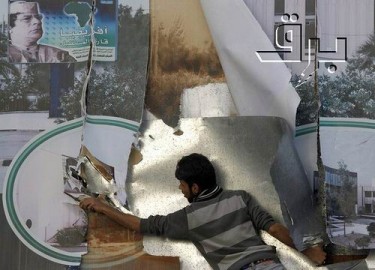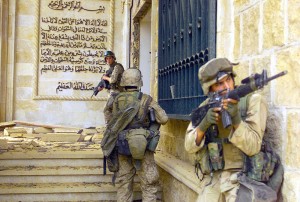 Three weeks ago, a BBC journalist experienced first hand the random brutality of Libyan leader Muammar Gaddafi’s security forces. Chris Cobb-Smith and two colleagues were heading to the town of Zawiya to cover the conflict, when security forces arrested them at a checkpoint and hustled them off to a makeshift prison. There guards repeatedly beat one of Cobb-Smith’s colleagues with a plastic pipe and other implements. The next morning, they drove Cobb-Smith and his associates to another compound and lined them up execution- style along a wall.
Three weeks ago, a BBC journalist experienced first hand the random brutality of Libyan leader Muammar Gaddafi’s security forces. Chris Cobb-Smith and two colleagues were heading to the town of Zawiya to cover the conflict, when security forces arrested them at a checkpoint and hustled them off to a makeshift prison. There guards repeatedly beat one of Cobb-Smith’s colleagues with a plastic pipe and other implements. The next morning, they drove Cobb-Smith and his associates to another compound and lined them up execution- style along a wall.
One of the guards pointed a submachine gun equipped with a silencer at the terrified men, and ordered them to face the wall. Then, as Cobb-Smith recalled in a recent interview, “he pointed the barrel at each of us. When he got to me at the end of the line, he pulled the trigger twice. The shots went past my ear.”
Cobb-Smith and his colleagues were released a few hours later, badly shaken by these experiences. But many Libyan civilians appear to have been far less fortunate. In May, International Criminal Court prosecutor Luis Moreno-Ocampo will present a report to the United Nations Security Council on alleged war crimes committed by Libyan security forces in the first days of the armed conflict, from February 15th to 26th.
I have become increasingly interested in these grim cases because archaeologists often take part now in the investigations, conducting excavations of mass graves. In recent years, archaeological teams have dug mass graves in Serbia, Spain, Afghanistan and many other troubled countries. But few of the cases, I think, have been as difficult and emotionally fraught as the excavation of 114 Kurdish civilians—almost entirely women and young children—who were shot while standing in a mass grave in Iraq in 1984 by the security forces of Saddam Hussein.
 Michael Trimble, a civilian archaeologist in the U.S. Army Corps of Engineers, headed the excavation, and from the start he knew it would be a very difficult assignment. Most crimes against humanity are investigated during peacetime, when researchers can exhume bodies patiently, without fear of attack. But Trimble and his team began their work in 2004, as Iraq was rapidly spiraling into civil war. No one could guarantee their safety. So Trimble and his colleagues worked as swiftly as possible without jeopardizing the case.
Michael Trimble, a civilian archaeologist in the U.S. Army Corps of Engineers, headed the excavation, and from the start he knew it would be a very difficult assignment. Most crimes against humanity are investigated during peacetime, when researchers can exhume bodies patiently, without fear of attack. But Trimble and his team began their work in 2004, as Iraq was rapidly spiraling into civil war. No one could guarantee their safety. So Trimble and his colleagues worked as swiftly as possible without jeopardizing the case.
It was a smooth, efficient, professional operation, but privately many team members felt themselves being drawn into the tragedy of the victims’ last moments. “You’re right on top of the bodies,” Trimble later told me, “cleaning them off really carefully and you’re as close as you can get to anyone.”
For some team members, the worst moments came when they excavated the bodies of women victims clutching their children. “I have cases that I can remember by what they were wearing and how they embraced each other, because I had to walk away,” recalled team member Susan Malin-Boyce later. “It had that effect on everybody. People developed a huge amount of compassion for the remains of the victims they worked on.”
But at the same time, Malin-Boyce noted, she and her colleagues were coolly analyzing the crime scene. “We were reconstructing what had happened and talking about what was going on. ‘Imagine bringing this group of people in here, marching them down here in the night in the headlights of the vehicles. Imagine the children crying and screaming and everyone begging.’ And at the same time, we were picking up the ballistic evidence and imagining it now from the perspective of a shooter. ‘How do you organize it? What do you do? Where was the heavy machinery?’ That’s just what archaeologists do. You create the scene from every possible perspective, so it’s not just the perspective of the victims that you are occupying when you are doing that. It’s the perspective of the shooter as well.”
Trimble presented the evidence as an expert witness in a war crimes trial held in Baghdad in late 2006. The Iraqi judges ultimately convicted three of the seven defendants of crimes against humanity and genocide and sentenced them to death. Two other defendants received sentences of life imprisonment.
Will archaeologists be called in one day to conduct similar excavations in Libya? I wouldn’t be at all surprised.
Photos: Upper photo. Street scene, courtesy of شبكة برق | B.R.Q. Middle Photo: US Marines cover each other as they prepare to enter one of Saddam Husseins palaces, courtesy Defense Visual Information Center.
It’s fascinating to think that here they kill all the witnesses, then people are able to reconstruct events so vividly that they can essentially bear witness after the fact, with all the attendant trauma to their psyches.
Jessa: Excellent point. I interviewed many of the people who took part in the Iraqi excavation, and I was struck by their profound emotional reaction to the work. Some cried as they related their experiences excavating the victims. What was fascinating, too, was how little these archaeologists wanted to return to regular archaeology afterwards. The investigation seemed give their lives new meaning and they wanted to do more such work.